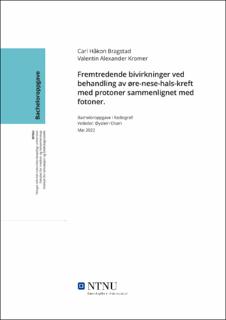| dc.contributor.advisor | Olsen, Øystein | |
| dc.contributor.author | Bragstad, Carl Håkon | |
| dc.contributor.author | Kromer, Valentin Alexander | |
| dc.date.accessioned | 2022-07-12T17:21:16Z | |
| dc.date.available | 2022-07-12T17:21:16Z | |
| dc.date.issued | 2022 | |
| dc.identifier | no.ntnu:inspera:110850715:111763995 | |
| dc.identifier.uri | https://hdl.handle.net/11250/3004879 | |
| dc.description.abstract | Tittel: Fremtredende bivirkninger ved behandling av øre-nese-hals-kreft med protoner sammenlignet med fotoner.
Deltakere: Carl Håkon Bragstad og Valentin Alexander Kromer
Veileder: Øystein Olsen
Stikkord/nøkkelord: Øre-nese-hals-kreft, stråleterapi, foton, protonterapi, bivirkninger
Antall sider/ord: 30/4722
Antall vedlegg: 1
Problemstilling: Hvilke bivirkninger er fremtredende ved protonbehandling i forhold til fotonbehandling av øre-nese-hals-kreft?
Hensikt: Hensikten med denne oppgaven er å undersøke hvilke bivirkninger, både akutte og sene, som forekommer hos pasienter som behandles for kreft i øre-nese-hals-regionen med protonterapi kontra konvensjonell stråleterapi.
Metode: Det ble benyttet en kvalitativ metode i form av en systematisk litteraturstudie for å besvare problemstillingen. Det er totalt 5 artikler inkludert, som omhandler bivirkninger og utfall ved behandling av kreft i hode og hals med fotoner og protoner.
Resultat: Resultatene viser at protonterapi kan ha mange fordeler sammenlignet med fotonbehandling på flere områder ved bestråling av hode og hals. Det ble blant annet sett fordeler ved dosereduksjon til friskt vev, i tillegg til lavere forekomst og alvorlighetsgrad av bivirkninger.
Konklusjon: Protonterapi kan assosieres med bedre utfall av bivirkninger som xerostomi, mukositt, dysgeusi, kvalme, dysfagi, og smerter. Pasienter behandlet med protoner hadde sjeldnere behov for PEG-sonde og brukte mindre narkotiske smertestillende i løpet av behandlingstiden. Disse fordelene kommer likevel på bekostning av høyere forekomst av dermatitt enn ved behandling med fotoner. | |
| dc.description.abstract | Title: Prominent adverse effects seen in treatment of head and neck cancer using protons in comparison with photons.
Participants: Carl Håkon Bragstad and Valentin Alexander Kromer
Supervisor: Øystein Olsen
Keywords: Head and neck cancer, radiotherapy, photon, proton therapy, adverse effects
Number of pages/words: 4722
Number of appendices: 1
Topic: Which adverse effects are prominent in use of proton therapy compared with photon therapy for treatment of head and neck cancer?
Purpose: The purpose of this study was to examine which adverse effects, both acute and long term, are prominent in patients treated for cancer in the head and neck region using proton therapy versus conventional radiotherapy.
Method: To answer the topic question, there was executed a qualitative method based on a literature review. There is a total of 5 articles included, researching adverse effects and outcomes in the treatment of head and neck cancer using photons and protons.
Results: The results show that proton therapy can have several advantages compared with photon therapy in multiple areas when irradiating the head and neck region. Among others, there were seen advantages in dose reduction in healthy tissue, as well as fewer and less severe occurrences of adverse effects.
Conclusion: Proton therapy can be associated with better outcomes of adverse effects such as xerostomia, mucositis, dysgeusia, nausea, dysphagia, and pain. Patients treated with protons less frequently required feeding tubes and used less narcotic analgesics during treatment. These advantages come at the expense of higher rates of dermatitis than seen with treatment using photons. | |
| dc.language | nob | |
| dc.publisher | NTNU | |
| dc.title | Fremtredende bivirkninger ved behandling av øre-nese-hals-kreft med protoner sammenlignet med fotoner. | |
| dc.type | Bachelor thesis | |
